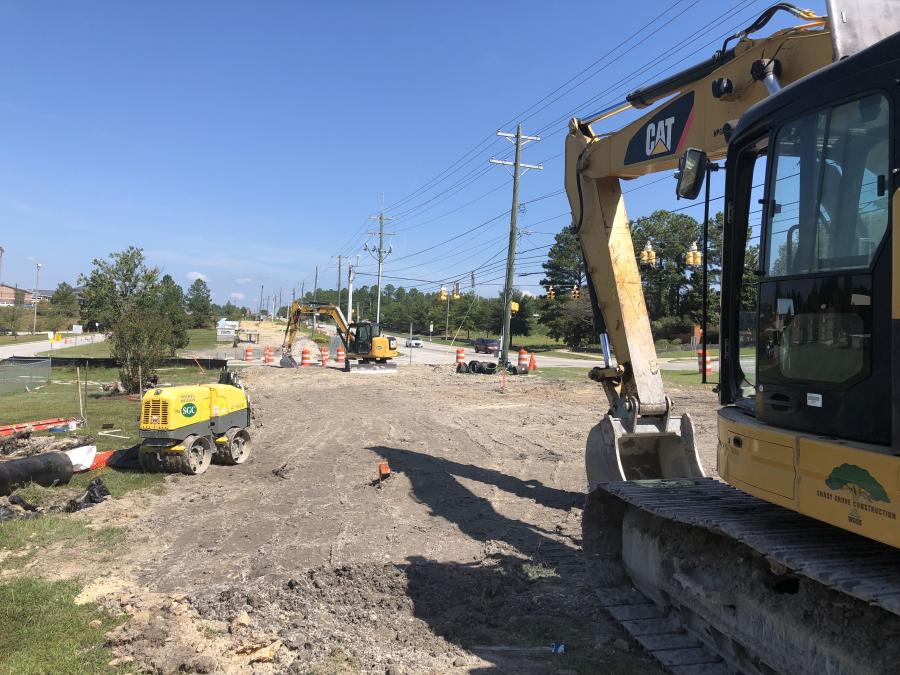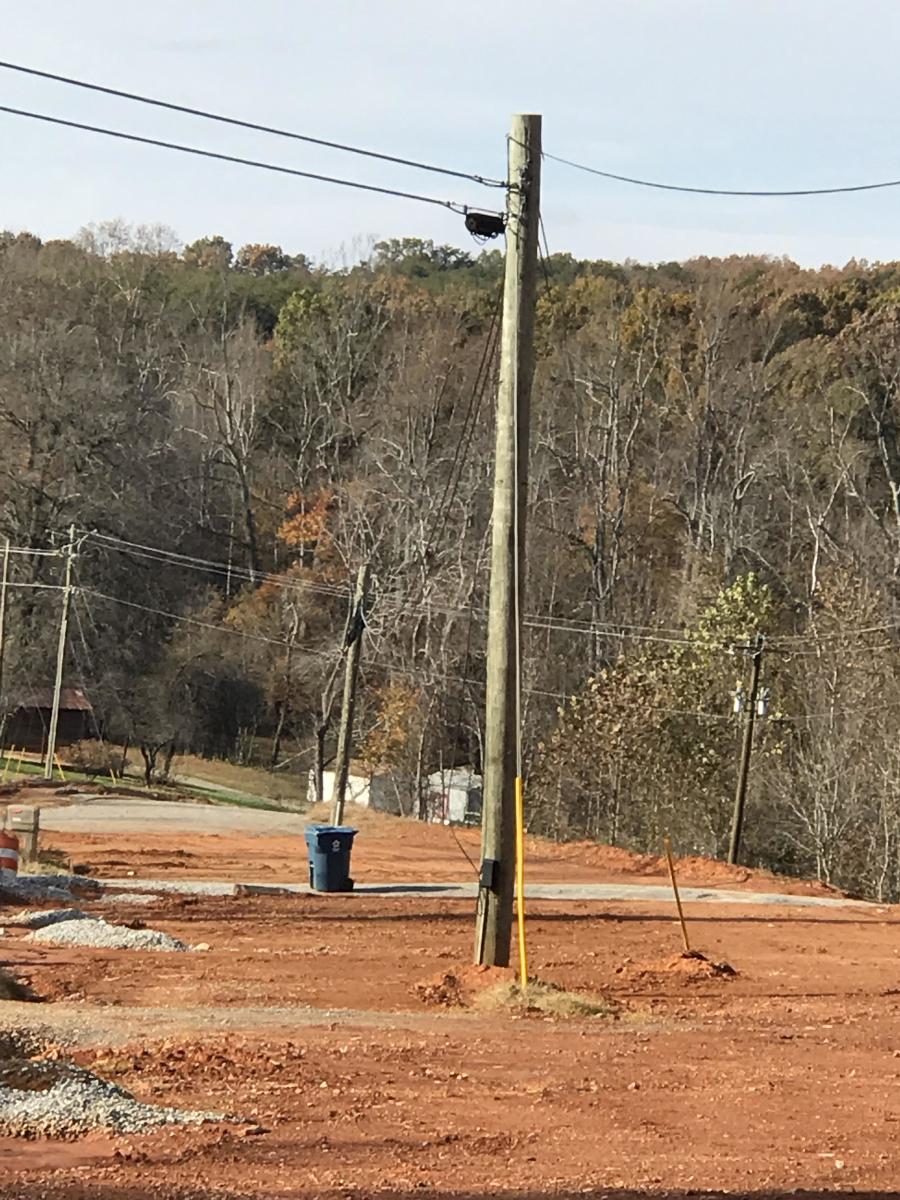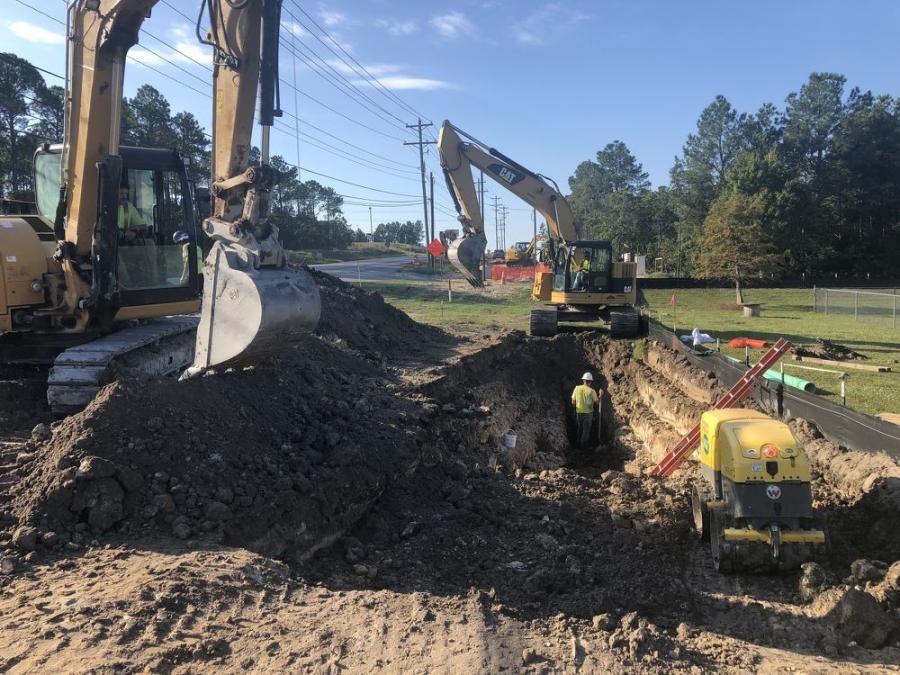Crews widening Hard Scrabble Road went where they could find space to work while waiting for the utilities to get out of the way.
Utility lines in the path of highway construction projects are an old and chronic national problem. Relocating lines so construction can advance almost invariably is a slow-motion process that causes general contractors to grind their teeth and DOT officials shake their heads.
But the problem hangs around, decade after decade.
For more than a hundred years, utilities of one kind or another have crowded highway rights of way. As utility lines have proliferated above and below ground — water lines, sewer mains, fiber optic cable — so has their presence alongside the country's aging roads. The Federal Highway Administration estimates more than 90 percent of today's highways were constructed before 1950, and the need to repair and widen the roadways runs headlong into all the utility infrastructure.
Since at least the 1970s, transportation agencies have tried to find a way to resolve the conflict. Entire manuals have been written on how to design, construct, maintain and relocate utilities in public rights of way. In 2004, for example, Indiana's DOT published a report subtitled, in 72-point type and all capital letters, "Accountability, Communication, Coordination and Cooperation" — as if to say, hey, this is important.
Yet some excerpts from the 15-year-old document could have been written yesterday: "Events in the past few years have made it clear that processes for highway improvement projects involving the relocation of utility facilities must change."
And this: "Bottom line, when highway improvement projects involve the relocation of utility facilities, all parties, including the public, deserve timely and cost-effective completion of these projects."
Easier said than done.
‘Hard Scrabble' Dilemma
The struggle to have utilities moved is "a constant, consistent, ever-present issue," according to Hugh Edwards, a project manager for South Carolina construction firm Palmetto Corp.
Edwards' management expertise comes from a business degree from the University of South Carolina and 20 years of overseeing major infrastructure projects. He currently manages a $64 million widening of Hard Scrabble Road on the outskirts of Columbia.
The project is set to be completed in mid-2021, but it has fallen behind schedule. How far?
 "We actually are in the middle of trying to determine that," Edwards said in late December. "For the most part, we were supposed to be way down the road."
"We actually are in the middle of trying to determine that," Edwards said in late December. "For the most part, we were supposed to be way down the road."
A nine-month utility relocation window was built in at the front of the schedule.
"It ended in June," Edwards said. "They were expected to have the majority of relocation work out of the way by then, but they didn't accomplish everything they were supposed to accomplish. Some parts of the job were ‘released,' but even in those areas there still are issues we're working around."
In October, state officials began to meet with Palmetto executives to "re-baseline" the project — that is, determine how far behind schedule it actually was. While the officials talked, Edwards shifted around his crews.
"We're going to places where we can find space to work, but it's getting to the point that we are going to be behind the eight ball unless the utilities get out of the way," he said.
The utility slowing the project the most, according to Edwards, is AT&T. But a variety of utility companies are involved, including South Carolina Electric & Gas and the cable-service provider Spectrum, as well as a local school district that wants to run fiber optic cable along the roadway.
"In a lot of places, I have old underground lines running beside the road," Edwards said. "I have old poles and new poles in the right of way, and both are energized. Sometimes, utility crews have come back and contaminated an area where we already have worked."
Edwards described a section of the project where someone failed to account for a planned turn lane.
"The utility contractor should have gone farther from the road, 58 feet instead of 45 feet," he said. "They laid the line as if the road were running straight through the section. Consequently, the line now lies where I need to put a storm drain."
As aggravating as that was to Edwards, the utility's response to his complaint was even more so.
"Their first response was, well, this will mean a nine-month delay for a redesign," he said. "They said that so DOT would come back and say, well, that's unacceptable, and they could start negotiating. I can't engineer the construction of a storm drain around that line. It's not doable. I don't know what the outcome will be."
In another instance, Edwards said, AT&T "basically put their stuff in the wrong place." He subsequently apprised the company that a water line would have to pass under the AT&T line. He asked the depth of the line so a contractor could safely bore under it. Over several days, he said, AT&T reps first balked, then argued, then showed up unannounced and left again when the contractor wasn't there.
"We finally got it worked out," he said. "I mean, did they really want us to wrap their cable around a bore machine because we didn't know how deep to run it?"
AT&T regional officials did not respond to phone calls asking for comment.
When conflicts aren't resolved in a timely way, work on the Hard Scrabble Road project ultimately stops, Edwards said.
"We'll stop for a day and come back, or two days and return, or send crews to another job and put this one on hold," he said.
All of which spells delay.
A Growing Problem
In neighboring North Carolina, the relocation conflict is no less urgent.
"From what I hear, it has always been a problem," said Carl Barclay, who is in his second year as a North Carolina Department of Transportation utilities manager. "It has become a somewhat bigger problem in the last five to 10 years."
Generally speaking, Barclay lays blame for project delays at several doorsteps, including the DOT's. For example, he noted that plan changes can be very disruptive.
"The biggest headache on a project is a last-minute design change," he said. "People don't understand the impact of that on a project. The powers that be don't understand. No one wants to acknowledge the difficulties it makes for utilities.
"It's a problem that is addressable," he added. "We need better communication within the department and a better understanding of the ripple effect of changes. We need to address that problem so it doesn't impact utilities quite so much."
Barclay also acknowledged that moving utilities is not a moneymaker for companies, which contributes to delays. After all, most — though not all — relocations are done at a utility company's expense because lines generally are allowed into the public right of way as a courtesy.
Consequently, Barclay said, "when the DOT comes along and asks a utility to relocate its lines, the utility gets nothing out of it. So, it puts off relocation as long as it can and focuses on activities that make it money."
In short, building out a new system eventually means additional utility company revenue, whereas relocation holds no such promise.
A $41 million highway-widening project in Catawba County is being watched closely by western North Carolina residents. About 8 mi. of two-lane NC 16 are being widened to four lanes for safer travel and to ease traffic on Interstate 77. The project was released to a general contractor in May 2017 with completion projected for January 2021.
As is customary, the contract stipulated which utilities had "facilities that will be in conflict with the construction of this project" and declared that "the conflicting facilities … will be adjusted prior to the Date of Availability unless otherwise noted."
The "conflicting" utility lines indeed might have been "adjusted" — whatever that might mean — prior to availability, but they were not relocated prior to the arrival of construction crews. So, the project lags.
 Projects haven't always started this way, according to longtime observers of highway contracting. The date of availability once meant contractors were assured utility lines were, in fact, out of the way. That formerly hard-and-fast date has been fudged in a rush to upgrade roadways. Today, contractors are given the go-ahead with fingers crossed.
Projects haven't always started this way, according to longtime observers of highway contracting. The date of availability once meant contractors were assured utility lines were, in fact, out of the way. That formerly hard-and-fast date has been fudged in a rush to upgrade roadways. Today, contractors are given the go-ahead with fingers crossed.
The NC 16 project is in NCDOT Division 12. Division construction engineer Larry Carpenter has overseen projects for 26 years and is reluctant to solely blame utility companies.
"We have problems on Highway 16, yes, but we also have problems on I-74 and on 273. All projects have utility issues," Carpenter said.
Yet he acknowledged that "Highway 16 work has been going on for over a year and does have some issues. It's getting to the point where it can start causing delays."
He also said that delays already bedeviled the project, with the road-widening work running about 10 percent behind schedule.
AT&T generally can be "slow to respond," Carpenter said, but he quickly added that "it's not always a hundred percent on them. It's hard to point your finger at one entity and say it's to blame. I don't want to throw rocks."
As an example, he noted that a pole in a right of way sometimes carries more than one utility line and AT&T can't move its lines until the others do.
Closer to Charlotte in DOT's Division 10, construction engineer Rick Baucom concurred that relocation delays "are a measurable problem," with contracts stipulating that utilities will be moved by such-and-such date.
"The problem is we are not meeting those dates," Baucom said. "So, there are delays and contractors are filing claims."
Baucom cited a contract in which a relocation date was agreed upon. In a follow-up meeting, the utility representative doubled the time he previously declared was needed to do the work.
"We ended up delaying that project a whole calendar year, March to March, and even the following March the relocation work wasn't complete," Baucom said.
The project still drags along.
Nationwide Concern
Slow utility relocation is not just a regional problem, and North Carolina transportation officials say similar concerns are voiced in conversations with peers in other states.
This proved true in a random call to Andrew Harmon, a DOT utility engineering specialist in Billings, Mont. Montana's population of just over 1 million people is one-tenth that of North Carolina's, and the state Montana maintains 75,000 fewer miles of roadway. However, the dynamics of road construction and utility relocation seem the same.
"Utility delays happen on every Montana project to some extent," Harmon said. "We try to coordinate all the relocations beforehand, but some utility companies operate with a fairly thin workforce and don't give themselves enough time. We try to dictate that relocation work needs to be done by a certain date, but then the utility starts late. On some projects, we get two or three utilities out of the way, but one is not finished, so there is delay."
Whether a project is slowed by relocation work depends almost entirely upon the performance of a utility contractor, Harmon said. When a line is slow to be moved, construction backs up.
"We try to work around it as much as we can, but there have been occasions when projects are closed down because of it," he said.
Possible Solutions
A 2003 Florida Department of Transportation study recommended that utility information flow more freely in highway jobs.
"Good practical solutions are possible with input from all the major project participants," the study said. "These solutions must consider all aspects of the project delivery process, including design, relocation activities and construction."
And then this: "Coordination, cooperation and communication throughout the project is the synthesis for smooth completion."
Barclay remains an advocate of earlier communication and closer coordination with utility companies. He rejected an initiative of several years ago that called for water and sewer lines to be relocated before a construction contract is awarded, preferring all the work to be part of one contract — even though frustrated contractors end up running skeleton crews while they wait.
On the other hand, Barclay has given division engineers some penalty power. Specifically, he said, division heads can withhold approval of future utility installations along rights of way if a utility company is behind in relocating old lines. This amounts to penalizing a utility for procrastination.
Using a penalty as an inducement is unusual because relocation is technically not a contractual matter. A North Carolina Highway consultant familiar with the issue, who spoke on condition of anonymity, said penalties are the heart of the matter.
"There are no penalties and therein lies the problem," he said.
Transportation officials "certainly have the authority to tell a utility, ‘Move a line out of the way or we will move the line and bill you,'" he added. "Yet there is no appetite to do that. It gets real political real fast."
Barclay acknowledged the political influence of utility companies.
"We respect utility companies' political power. We don't need to go poke them and get ourselves in a corner," he said.
Even so, Barclay has given division engineers the leeway to push the issue.
"We are not going to tell the chief engineer in each of our divisions that he can do it or can't do it," he said. "If an engineer does do it, it should be done very judiciously.
"Withholding approval is effective. What concerns me is if approval for a proposed new utility installation is withheld and it turns out to be for a hospital or a school or something. That could backfire."
In any event, withholding approval doesn't seem to be a cure-all. Baucom said approval for new utility lines in Division 10 was withheld in two different cases — three times for a local telephone company — with mixed results.
"We told the company we were not going to accept any more encroachment proposals from them until XYZ was done on a construction project," he said. "That helped temporarily, but then they went right back to their old ways."
Out in Montana, Harmon said withholding approval has never been tried.
"We haven't, that I know of, tried penalizing a utility," he said. "We have contractual expectations, but no penalties. For one thing, some of these local utility companies are really small and a penalty could break them."
Harmon said better coordination is the answer. So did Edwards, adding that a strong coordinator should be authorized to hold utility companies accountable for their performance over the entire life of a project.
As a practical matter, Edwards also would have underground work done in a certain order. That is, box culverts running under roadways and sewer lines that must be installed on a certain grade would get first dibs for placement. That way they wouldn't run into buried fiber optic and other lines arbitrarily placed in their path, he said.
Some professionals are hoping for a legislated solution. Constituents aghast at the slow-moving Highway 16 widening project have reached out to their North Carolina state Sen. Andy Wells, a Republican who brings relevant credentials to the discussion as a real estate developer and the holder of two engineering degrees from North Carolina State University.
"Constituents have raised the issue with me, and I've started investigating it," Wells said in early January. "It appears that utility lines are holding up the project. I've never before seen utility poles sitting in the middle of a highway project right of way."
Wells said he hasn't begun to reach any conclusions, but, he added, "it appears to be a question of a general contractor attempting to build a road and utilities are not being moved in a timely manner."
"If that's the case, there will be conversations," he said. "I'm waiting to see if a contractor comes forward and says he has incurred X number of dollars in delays. If that happens, we will have a number to talk about. Utility delays that result in additional construction costs might be hard to defend."
Should the North Carolina General Assembly take on the issue — with input from utility company lobbyists, of course — a workable solution might result.
The outcome certainly would be of interest to frustrated contractors and utility companies across the country.
CEG
Today's top stories







 "We actually are in the middle of trying to determine that," Edwards said in late December. "For the most part, we were supposed to be way down the road."
"We actually are in the middle of trying to determine that," Edwards said in late December. "For the most part, we were supposed to be way down the road." Projects haven't always started this way, according to longtime observers of highway contracting. The date of availability once meant contractors were assured utility lines were, in fact, out of the way. That formerly hard-and-fast date has been fudged in a rush to upgrade roadways. Today, contractors are given the go-ahead with fingers crossed.
Projects haven't always started this way, according to longtime observers of highway contracting. The date of availability once meant contractors were assured utility lines were, in fact, out of the way. That formerly hard-and-fast date has been fudged in a rush to upgrade roadways. Today, contractors are given the go-ahead with fingers crossed.











